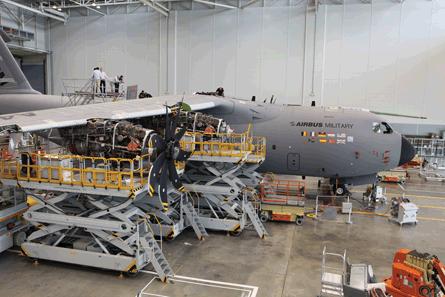Having served for the past 15 months as a resolutely earthbound monument to all that can go wrong with big-ticket pan-European defence projects, the Airbus Military A400M is finally poised to deliver.
Beset by problems associated with the aircraft's unprecedentedly complex full-authority digital engine control software since its official roll-out in June 2008, a mood of cautious optimism is returning to the project's Madrid management team.
Although no one is promising a maiden flight before February, the manufacturer has good reason to whisper that Europe's flagship transport is likely to get airborne before the end of the year.
"We faced some development issues in the past, but now we have overcome them," says Airbus's A400M programme head, Rafael Tentor.
 |
|---|
© Airbus Military |
The long delay to the first flight of MSN001 has at least given Airbus the opportunity to carry out more extensive maturity testing of the aircraft's systems. This, it hopes, will enable it to compress the flight-test campaign and make up some lost time by reducing downtime between test sorties.
HIGHER MATURITY
For example, the flight-control software that is now being loaded has "a maturity much higher than before", says Tentor.
Airbus was last week due to receive the final release of the Europrop International TP400-D6's long-awaited FADEC software.
"We have just a handful of issues needing correction before first flight," says Tentor. "We intend to hand over the aircraft for engine ground runs in November, and are increasingly confident we will perform the first flight by the end of the year. At the moment we are on track, and our confidence is increasing every day."
The TP400's Lockheed Martin C-130 flying testbed is due to make just two more flights, after which the aircraft will "definitely be grounded", says Tentor.
Two more A400Ms are scheduled to joint the flight-test programme in rapid succession. The first flight of MSN002 is targeted for the second quarter of 2010, with the third aircraft to follow soon afterwards. These aircraft will be used primarily for powerplant and systems testing, respectively. MSN004 will support development of the cargo system.
KEY FACTSHeading for first flight: The following tasks stand between the A400M and its maiden sortie, expected to occur before year-end:
|
Construction of MSN005, which is a customer aircraft and not part of the test programme, has been delayed to ensure it is built in line with the final post-flight-test specification.
"We don't want to accumulate non-standard aircraft parts," says Tentor. "We want to prevent iterations and retrofits."
The production plan calls for MSN006 to be the first aircraft to come off the line in the full production configuration, and MSN007 will be the first aircraft to be delivered to a customer.
Some issues have been encountered during development of the Thales flight-management system, but "we have a plan agreed with Thales and presented to the customer", says Tentor. Thales says the problems have "now been overcome".
Results from static and fatigue testing of A400M airframes, being performed in Madrid and Dresden, respectively, have led to minor modifications and reinforcements to the first three flight-test aircraft to "ensure full flight envelope capability", says Tentor. "We have not found any major structural issues," he adds.
Airbus has set a "maturity gate" one year after first flight, when modifications required to be made ahead of first delivery will be defined, to "ensure that we deliver a mature aircraft", says Tentor. The airframer has decided service entry will not occur until three years after first flight.
European procurement agency OCCAR, meanwhile, has a permanent team in Toulouse, with the aim of finalising a new contract on behalf of the A400M's customer nations by year-end.
"We are in permanent dialogue, and we are now down to the details," says Tentor. "We have an agreement on the principles of all the areas."
The A400M's contracted payload capability is 37t, including up to 5t of customer configuration-specific items already under development, leaving a "free" payload of 32t. "The weight [of the aircraft] is under control," says Tentor. "It is in line with the payload that we have committed to the customer."
Source: Flight International



















